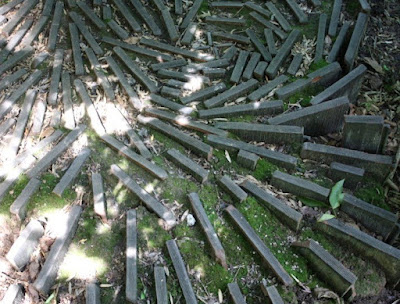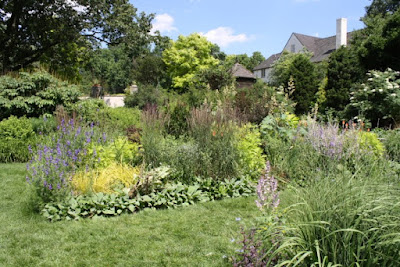 A Simple Love of Plants
A Simple Love of PlantsThe candelabra-like spent flower heads of Prairie Dock (Silphium terebinthinaceum) rising to ten and twelve feet in the photos above and below add a sense of magic, suspended as they are, like vegetable jewels, on amazingly strong stems above the surrounding plantings, dancing entwined with tall black-beaked, seed-heavy rods of Rudbeckia maxima. (Click on the photos to see detail.)
 This is the same pleasure most gardeners find in plants, a simple passion for plants, a sensuous response to THE PLANT. Period. It has little to do with aesthetics of the garden as a whole.
This is the same pleasure most gardeners find in plants, a simple passion for plants, a sensuous response to THE PLANT. Period. It has little to do with aesthetics of the garden as a whole.Private Meanings
On another level, appreciation of a planting can be a door to a personal world of private meaning. The plants in the next photo, delicately accented by flowering panicles of Molinia 'Transparent', can be seen as metaphor; they bring to my mind the quantum foam conceived by physicists, where matter and energy dance at some subatomic level, matter popping into and out of existence, changing into energy and back to matter eternally, a bubbling brew where we confront the hard edge of existence, being and non-being.
 Analogy as a Way of Seeing and Understanding
Analogy as a Way of Seeing and UnderstandingMusical analogy is another pleasing way to see a garden - think variations on a theme - the infinite variety of plant shapes, textures, leaf forms, movements, rhythmic changes over time - revealing similarities and differences in form, bearing, or other attributes. Below, mounds of Miscanthus 'Silberfeder', their ribbon-like foliage echoed in altered form by the tall wavy arms of the Japanese Fantail Willows (Salix sachalinensis 'Sekka') behind them, contrast with the big, low leaves of the Petasites at their base (the bass viol in this musical analogy?) ... in late summer the dusty silver of Mountain Mint (Pycnantheum muticum) flowing through it all like the sparkling high notes of a piccolo.
 What is Structure in a Naturalistic Garden?
What is Structure in a Naturalistic Garden?Below, a simple garden path defines the edge of the open space and of the garden, the boundary - a reminder of the garden's structure, largely invisible at this time of peak growth. Naturalistic as the garden is, even approaching wildness, particularly to more traditional gardeners, this is a structured space. The structure takes its impetus from the river delta-like drainage flow across the garden, from the linear pond at the entrance into the open garden, from the native stone walls emulating ancient stone rows built here in previous centuries, and from the circular clearing in the woods that defines the space of the cultivated garden - and from the plants themselves, placed to reflect similarities in form and structure, planted to create drifts, to create a visual sense of movement, even to tell a story.
 While it's possible to enjoy the plants alone, if the whole isn't more than the sum of its parts, a garden is little more than a private collection of perennials, shrubs and trees. Without structure, it could just as well be the plant growing-on part of a nursery. Structure holds it all, helps give it meaning, and evokes an intellectual pleasure - each part fitting into a perceived whole. Piet Oudolf's gardens, for example, use blocks of single species to create structure, strategically placed shrubs and topiary to manipulate the sense of depth, hedges to hold the looseness of the naturalistic structure.
While it's possible to enjoy the plants alone, if the whole isn't more than the sum of its parts, a garden is little more than a private collection of perennials, shrubs and trees. Without structure, it could just as well be the plant growing-on part of a nursery. Structure holds it all, helps give it meaning, and evokes an intellectual pleasure - each part fitting into a perceived whole. Piet Oudolf's gardens, for example, use blocks of single species to create structure, strategically placed shrubs and topiary to manipulate the sense of depth, hedges to hold the looseness of the naturalistic structure.Open space, the void that makes possible the view through and across the garden, given emphasis by the red circle of logs at the vanishing point in the photo below, is intrinsic to its structure - open space bounded by the wall of surrounding wood, but with occasional glimpses into corridor views opened by tree felling, or simply views into the interstices between the trees (an effect much more pronounced in winter when the leaves have fallen). And above it all the dome of sky opens the garden to the universe, yet is circumscribed by the circle of trees that enclose the space, too closely I think. Closed openness, like a nest.
 Pleasure in Detail
Pleasure in DetailAs I walk through the garden, likeness and difference, similarity and contrast return my eye to the material aspects of the garden: a sanguisorba given by a fellow gardener, Mirjam Farkas, so different in structure from the flowering Joe Pye Weed (Eupatorium purpureum) behind it, yet so similar in color, brings to mind another reason for gardening, many as they are - in this case the pleasure of differentiating between similar and dissimilar things, something we observe in small children playing with shaped objects ...
 ... or simply delighting in the detail of small things.
... or simply delighting in the detail of small things. Or taking pleasure in durable, sturdy form as with this Queen of the Prairie (Filipendula rubra 'Venusta'), still giving a good show two months after its blossoming time in spite of a summer of heavy rain.
Or taking pleasure in durable, sturdy form as with this Queen of the Prairie (Filipendula rubra 'Venusta'), still giving a good show two months after its blossoming time in spite of a summer of heavy rain. Distance, Space, Large Scale Structure
Distance, Space, Large Scale StructureThick as the garden is planted, the architecture of the space reveals itself only over distance. The vertical cedar trunks 300 feet across from the viewpoint below provide a reference point, making it possible to "see" the intervening space.
 Moving to the left, the distant framework stays the same, while the foreground changes, showing different plant forms and plant combinations. Here panicums, irises, a lone cimicifuga (actea), Silphium perfoliatum, Arborvitae (Thuja occidentalis), Miscanthus giganteus on the right.
Moving to the left, the distant framework stays the same, while the foreground changes, showing different plant forms and plant combinations. Here panicums, irises, a lone cimicifuga (actea), Silphium perfoliatum, Arborvitae (Thuja occidentalis), Miscanthus giganteus on the right. Moving left, looking across the pond (hardly visible), petasites, cattails (typha), Sweet Bay Magnolia (Magnolia virginiana), river birch in the mid-distance, floppy flowering Miscanthus 'Silberfeder' at the far side.
Moving left, looking across the pond (hardly visible), petasites, cattails (typha), Sweet Bay Magnolia (Magnolia virginiana), river birch in the mid-distance, floppy flowering Miscanthus 'Silberfeder' at the far side. Transient Structure of Plants
Transient Structure of PlantsAnd last, a closer view, taken with a small aperture to gain maximum depth of field, bringing multiple layers of the scene into focus. This foreground, the plants themselves, are transient structure, changing from hour to hour, day to day, season to season - the abstract and concrete in interplay, visible and invisible structure making the garden.

More Questions
In the end, this post raises more questions than it answers. Plenty of room for exploration of the concept of structure, especially in naturalistic gardening, remains. The role of memory as a starting point and source of pleasure is clearer. What gives pleasure is, of course, a highly subjective thing. I know from personal experience that many people are uncomfortable, if not frightened, in my garden, in most cases I think because they are intimidated by plants larger than themselves. But I'm not trying to start a movement.




































